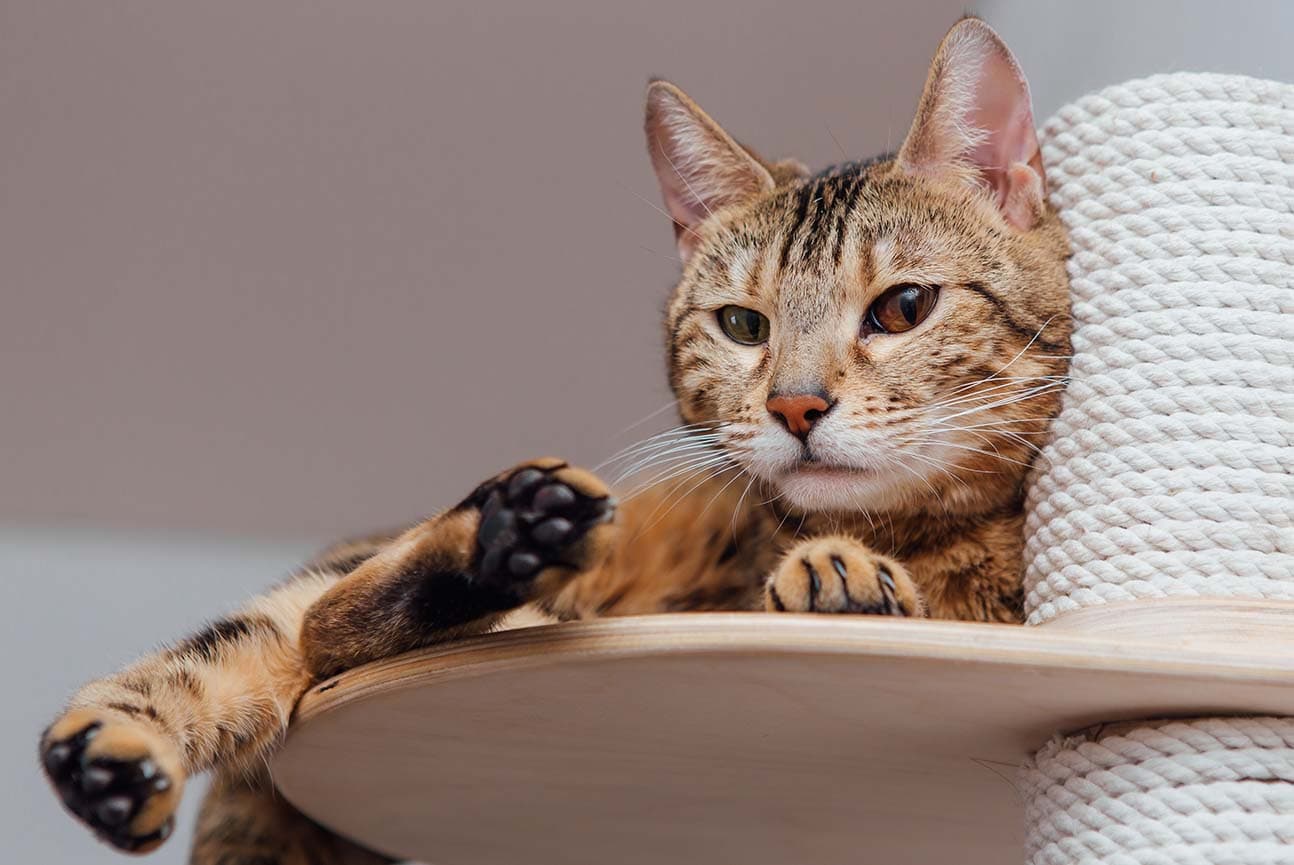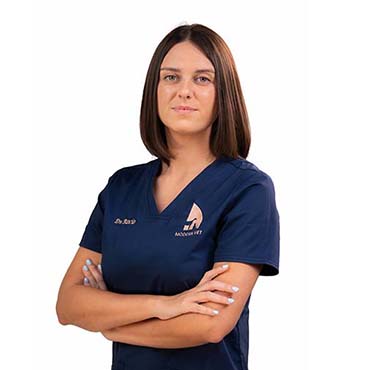Reviewed by Dr. Rocio Mena
Updated on 21/10/2025
Reading time 4 min.
Overview
Severity: Low
Life stage: All
Recognising pain in cats can be challenging. As both predators and prey animals, they’ll instinctively mask discomfort, making signs subtle or manifesting as changes in behaviour, grooming habits or social interaction.
Pain can affect cats of any age or breed, from playful kittens to elderly cats managing age-related health conditions. It may be acute (short-term) or chronic (long-term). In Dubai, factors like reduced outdoor activity, effects of air conditioning and stress from changes and confined living can present unique challenges for feline wellbeing.
Important Safety Warning: Human pain relief medications are highly toxic to cats and can be fatal. Never give your cat any human medication without first consulting a qualified veterinarian.
What to do if your cat is in pain
If you suspect your cat is experiencing pain, contact a veterinarian immediately.
A qualified veterinarian will:
- Assess whether your cat requires immediate physical assessment by a vet
- Determine whether diagnostic tests are necessary
- Prescribe appropriate pain relief medication if needed
In the meantime, ensure your cat has access to a quiet, comfortable resting area away from household noise. Avoid touching any areas that appear painful. Keep fresh water readily available; this is particularly important in the UAE’s dry climate, where dehydration can quickly become serious.
How to Tell if Your Cat is in Pain
Physical signs
- Limping, stiffness or moving more slowly: especially after jumping down from higher surfaces
- Eating and drinking less: concerning in Dubai’s dry climate, where dehydration is a risk
- Excessive licking or biting at specific body areas, leading to hair loss or wounds
- Decreased grooming: resulting in poor coat condition and matted fur
- Breathing more quickly, panting, open mouth breathing: unusual in cats and indicates significant discomfort
- Toileting outside the litter box: pain may prevent access to litter tray and normal posturing
Behavioural signs
- Sleeping more than usual and reduced activity
- Uncharacteristic aggression or irritability towards people or other pets
- Hiding away: less social interaction with family
- Avoiding jumping onto higher kitchen surfaces, furniture or climbing cat trees
- Shaking and trembling
- Increased vocalisation: hissing, growling, yowling or unusual meowing patterns
Facial expressions
Watch for subtle expressions indicating discomfort:
- Eyes: narrowed, squinting, or half-closed
- Ears: flattened against the head or drooping
- Mouth/nose: tense, tight expression around muzzle
- Overall expression: withdrawn, less responsive, ‘worried’ appearance
Body language
- Hunched posture: back arched, head held lower than normal
- Tense body: rigid stance when approached
- Flinching when touched: particularly around painful areas
- Reluctance to move: staying in one position for extended periods
Most Common Causes of Pain in Cats in Dubai
Musculoskeletal issues
- Sprains and strains from jumping or falls
- Arthritis: potentially worsened by air-conditioning
- Hip dysplasia and joint developmental problems
Indoor lifestyle-related conditions
- Obesity-related joint stress from reduced activity
- Urinary tract problems from stress, obesity or inadequate water intake
- Dental disease: poor diet and lack of preventive care
- Severe constipation: more likely where inactive and dehydrated
Common health problems
- Skin and ear infections: worsened in heat, humidity and in air-conditioned environments
- Dental and gum disease: particularly prevalent in indoor cats
- Pain after surgery
- Fight injuries and bite wounds: following encounters with other household pets
Serious internal conditions
- Blood clot: often associated with heart disease or hyperthyroidism
- Pancreatitis
- Blocked bladder: an emergency condition requiring immediate treatment
- Respiratory and urinary tract infections
- Intestinal blockages: foreign bodies (toys, string)
- Cancer
When pain is immediately worrying in cats
Seek immediate veterinary attention if your cat:
- Cannot bear weight on one or more legs
- Becomes paralysed or shows sudden loss of movement
- Requires immediate pain relief
- Suddenly becomes aggressive and hasn’t had a recent physical examination (within the last 6-12 months)
- Shows difficulty breathing
- Has not used the litter tray for over 24 hours
How to prevent pain or reduce pain for your cat
Environmental considerations
- Maintain a consistent, comfortable temperature throughout your home
- Provide multiple levels to explore and safe climbing opportunities
- Ensure mental stimulation to prevent boredom eating, harmful behaviour and obesity
- Create quiet, safe spaces: away from household activity and other pets
- Ensure sufficient food, water and number of litter trays for all of cats in the household
- Monitor multi-cat interactions to prevent fights and injuries
Routine and preventive healthcare
- Schedule regular veterinary check-ups every 6-12 months
- Keep vaccinations and parasite preventatives up-to-date
- Monitor your cat’s weight and body condition: obesity significantly increases risk of pain
- Consider veterinarian-recommended joint supplements for adult and elderly cats
- Maintain consistent daily dental care from kittenhood
Activity management
- Encourage exercise through interactive play
- Provide scratching posts and climbing trees
Diagnosis of the Different Causes of Pain
Your vet will take a thorough clinical history, including when the problems started, how they affect your cat, background details, and any changes in lifestyle. They will conduct a full physical examination. Based on their findings, your vet may advise further tests:
- Blood and urine tests: assessing inflammation, organ health and function, and hydration
- Imaging (X-rays, ultrasound): for joint problems and internal conditions
- Advanced imaging (CT, MRI): for spinal or neurological issues
- Specialised tests for complex cases and conditions common in the region
How to help your cat at home if they’re in pain
Environmental Support
- Provide comfortable, quiet, easily-accessible resting areas
- Use low-sided litter trays that are easy to enter
- Keep food and water bowls within easy reach
- Consider raised feeding stations for neck or back pain
Medical care
- Give prescribed medications exactly as directed
- Never use human medications without veterinary approval
Physical comfort
- Use heat packs for muscle pain (ensure they’re not too hot)
- Apply towel-wrapped ice packs for acute injuries
- Consider vet-recommended joint supplements
Activity management
- Follow any advice regarding exercise restrictions
- Prevent jumping and climbing if recommended
- Monitor closely for improvements or deterioration
Veterinary treatment options for pain in cats
Effective treatment depends on identifying the underlying cause of pain.
Pain relief medications
All veterinary painkillers require a prescription. Your vet will select the safest options specifically formulated for cats:
- Non-steroidal anti-inflammatory (NSAIDs): for joint pain and injury
- Opioids: for severe pain
- Gabapentin: effective for nerve pain
- Amantadine: for chronic pain management, often alongside other drugs
- Frunevetmab: a monthly injection for arthritis that blocks pain signals at the source
Targeted treatments
- Antibiotics or antifungals for infections
- Digestive support medication: anti-nausea, appetite stimulants, and gastric protectants
- Urinary medications and prescription diets for bladder conditions
- Thyroid medications for hyperthyroidism-related complications
- Heart medications and anti-clotting drugs for cats at risk of blood clots
- Cancer therapies
Surgical Procedures
When necessary for conditions such as dental disease, urinary blockages, and spinal problems.
Complementary Therapies Available in Dubai
- Acupuncture: offered by qualified veterinary practitioners
- Physiotherapy: particularly beneficial for post-surgical recovery
- Laser therapy: to reduce pain and inflammation
- Hydrotherapy: uncommon, requires specialist facilities and acclimatisation for the cat
Are some cats more at risk of pain than others?
Age-related risks:
- Elderly cats: more susceptible to arthritis, dental disease and organ-related pain
- Kittens: vulnerable to growth-related problems and injury from falls/mishaps
Breed predispositions:
- Large breeds (Maine Coons, Ragdolls): higher arthritis and blood clot risk
- Persian and brachycephalic (short-faced) breeds: increased dental disease and respiratory issues
- Scottish Fold cats: genetic (inherited) joint abnormalities causing chronic pain
- Abyssinians and Somalis: increased risk of dental disease
Environmental factors in Dubai:
- Indoor-only cats: increased risk of obesity, predisposing to pain and joint problems
- Multi-cat households: greater stress and potential for conflict-related injuries
- Cats with limited environmental enrichment (boredom): prone to behavioural and stress-related conditions
Worried your cat may be in pain? Cats often hide discomfort, so subtle changes in behaviour or mobility can signal serious issues. Book a checkup or emergency appointment at Modern Vet Hospital in Dubai. Our experienced team offers expert diagnostic services, pain management, and ongoing care tailored to feline needs. From early detection to treatment of chronic or acute pain, Modern Vet Hospital is your trusted veterinary clinic in Dubai for compassionate, effective cat care.
Share this, choose your platform!
Reviewed by
Dr. Rocio Mena
DVM
Dr. Rocio Mena was born in Spain and discovered her passion for veterinary medicine early in life. She pursued this dream and graduated from CEU University in Spain in 2018 with a degree in…


